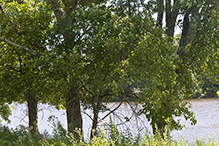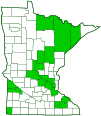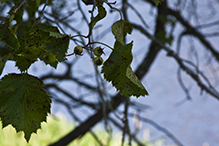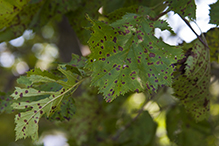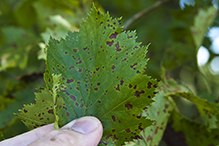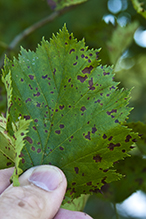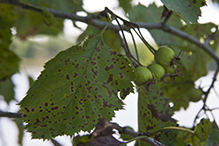Quebec hawthorn
(Crataegus submollis)
Conservation • Description • Habitat • Ecology • Use • Distribution • Taxonomy
Conservation Status |
|
|||||||
| IUCN Red List | not listed |
|||||||
| NatureServe | NNR - Unranked SNR - Unranked |
|||||||
| Minnesota | not listed |
|||||||
Description |
||
Quebec hawthorn is a tall shrub or small tree that rises from a woody, branching root system. It can be up to 30′ in height and up to 6″ in diameter at breast height. The crown is densely branched. There are 1⅜″ to 2¾″ long, unbranched, shiny thorns at the nodes of the branches. There are no compound thorns. The bark is thin and gray. Bark on young branches and trunks is smooth. Bark on older branches and trunks is separated into flat, plate-like scales. Twigs are relatively slender. They are light green and densely covered with long, white hairs early in the season of the first year, later covered with long, soft, woolly hairs; brown or grayish-brown and hairless the second year; and gray and hairless in the third year. Young twigs have minute, pale, round dots (lenticels). Buds are plainly visible, not submerged or partially hidden. They are covered with 2 or more dark red, thick, fleshy, hairless, somewhat fleshy scales. They are gummy when pressed between the fingers. The terminal bud is round to egg-shaped. The leaf scar is flat or only slightly raised, and has 3 bundle scars. The pith is round or nearly round and solid, not spongy. The leaves are alternate and deciduous. They are on slender, light green to reddish-green leaf stalks (petioles). The petioles are ½″ to ¾″ long when the tree is in flower, ¾″ to 1½″ long at maturity. Early in the season they are densely covered on all surfaces with short, soft, matted or tangled, woolly hairs. They become sparsely hairy or almost hairless late in the season. They are not winged. They may have 2 to 5 stalkless, red glands on the margins. The leaf blades at flowering time are about three-quarters grown, thin, and hairy above and below. At maturity they are thick, firm, egg-shaped or broadly egg-shaped to nearly circular, 2⅜″ to 3¾″ long, and 2⅜″ to 3¼″ wide. They are wedge-shaped, rounded, or broadly angled at the base, and angled at the tip. They have 3 to 5 pairs of small lobes on each side. The lobes are relatively shallow, 3 ⁄16″ to ⅜″ long. Early in the season, when the leaves unfold, the upper surface is densely covered with short, pale hairs and the lower surface is covered with short, soft, matted or tangled, woolly hairs. At flowering time both surfaces are hairy. At maturity, the upper surface is dark green, dull, rough to the touch, and sparsely covered with short, stiff hairs. The lower surface is pale green, dull, and covered short, soft, wavy or appressed hairs, especially but not only along the main veins. By fall the lower surface is often almost hairless. The veins are impressed on the upper surface and raised on the lower surface. There is a prominent midvein with primary veins extending to the tip of each lobe. The margins are coarsely, irregularly toothed with sharp, forward pointing teeth. The teeth are tipped with small, dark glands. The inflorescence is a branched, flat-topped cluster (corymb) of 6 to 15 flowers at the ends of twigs and branches. The stalks of the corymb and stalks of individual flowers are hairy. Each individual flower is ⅝″ to ⅞″ in diameter. There are 5 greenish sepals, 5 white petals, and 7 to 10, stamens. The anthers are creamy white. The fruit is a seed capsule with a fleshy, outer covering (pome). The pome is globe-shaped and ⅜″ to ¾″ in diameter. It is green at first, becoming dull red when it reaches maturity September 3 to 25. |
||
Height |
||
Up to 30′ |
||
Flower Color |
||
White |
||
Making the Identification |
||
The terminal shoot of a twig produces leaves whose shape may not be representative of the species. Identification should be made using leaves occurring on short, lateral shoots of an older twig. |
||
Similar Species |
||
| Downy hawthorn (Crataegus mollis) is always a tree, never a shrub. There are usually large, compound thorns near the base of the stem and on the larger branches. The twigs are thick. The leaves are larger and have larger, deeper lobes. The flowers may be larger, up to 1¼″ in diameter, and have 17 to 20 stamens. | ||
Habitat |
||
Dry to moderate moisture. Forest edges, brushy thickets. Partial shade. |
||
Ecology |
||
Flowering |
||
May 12 to June 3 |
||
Pests and Diseases |
||
|
||
Use |
||
|
||
Distribution |
||||
|
Sources |
|||
| 3/26/2023 | ||||
Nativity |
||||
Native |
||||
Occurrence |
||||
Uncommon |
||||
Taxonomy |
|||
| Kingdom | Plantae (Plants) | ||
| Division | Tracheophyta (Vascular Plants) | ||
| Subdivision | Spermatophytina (Seed Plants) | ||
| Class | Magnoliopsida (Dicots) | ||
Order |
Rosales (Roses, Elms, Figs, and Allies) | ||
Family |
Rosaceae (Rose) | ||
| Subfamily | Amygdaloideae | ||
| Tribe | Maleae | ||
| Subtribe | Malinae | ||
Genus |
Crataegus (hawthorns) | ||
| Section | Coccineae | ||
| Series | Molles | ||
Subordinate Taxa |
|||
|
|||
Synonyms |
|||
Crataegus arnoldiana Crataegus canadensis Crataegus champlainensis |
|||
Common Names |
|||
| Quebec hawthorn | |||
Glossary
Corymb
A flat-topped or convex inflorescence in which the stalked flowers grow upward from various points on the main stem to approximately the same horizontal plane. The outer flowers open first.
Lenticel
A corky, round or stripe-like, usually raised, pore-like opening in bark that allows for gas exchange.
Petiole
On plants: The stalk of a leaf blade or a compound leaf that attaches it to the stem. On ants and wasps: The constricted first one or two segments of the rear part of the body.
Pith
The spongy cells in the center of the stem.
Pome
A fruit with a central seed bearing core enclosed in thick flesh, e.g., an apple or pear.
Stipule
A small, leaf-like, scale-like, glandular, or rarely spiny appendage found at the base of a leaf stalk, usually occurring in pairs and usually dropping soon.

Slideshows |
||

Visitor Videos |
|||
Share your video of this plant. |
|||
| This button not working for you? Simply email us at info@MinnesotaSeasons.com. Attach a video, a YouTube link, or a cloud storage link. |
|||
Other Videos |
|||
| Crateagus submollis - Samtiger Weißdorn skymountain |
|||
About
Uploaded on Feb 7, 2012 Die Weißdorne (Crataegus) sind eine Gattung von Sträuchern oder kleinen Bäumen der Kernobstgewächse (Pyrinae) innerhalb der Familie der Rosengewächse (Rosaceae). Es gibt 200 bis 300 Arten in den gemäßigten Klimazonen der Nordhalbkugel. Der Verbreitungsschwerpunkt liegt in Nordamerika, insbesondere im östlichen Nordamerika. In Europa werden etwa 22 Arten unterschieden, in Deutschland drei, deren Unterschiede zumeist nur von Fachleuten wahrgenommen werden. Da die Arten innerhalb der einzelnen Regionen leicht miteinander bastardieren, ist eine sichere Bestimmung schwierig. |
|||

Visitor Sightings |
|||||
Report a sighting of this plant. |
|||||
| This button not working for you? Simply email us at info@MinnesotaSeasons.com. Be sure to include a location. |
|||||
|
|||||
MinnesotaSeasons.com Sightings |
|||||

|
Created: Last Updated: © MinnesotaSeasons.com. All rights reserved. |
